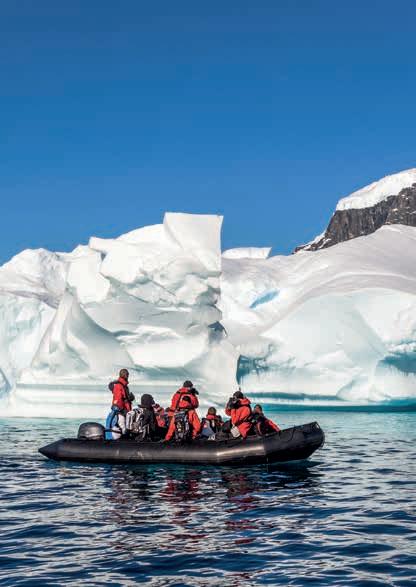
2 minute read
Polar Expedition Voyages
To visit the Arctic and Antarctic is to travel to regions like nowhere else on Earth. These frozen lands are home to some of the world's most unique wildlife and offer unforgettable wildlife encounters, from seeing the iconic polar bear, to sitting amidst huge colonies of penguins in a vast, icy wilderness. We arrange dedicated charters to the Arctic and Antarctic, as well as tailor-made options on hand-picked vessels and recommended itineraries.
Visiting the Polar Regions
As the most remote locations on the planet, trips to both the Arctic and Antarctic can be time-consuming and complex adventuresbut the rewards once you’re there are out of this world. The Arctic is home to the world's largest terrestrial predator, the polar bear, as well as gargantuan marine species such as walruses. Penguins – from emperor to Adelie – are the specialities of Antarctica, but it’s also a feeding ground for a multitude of great whales, most notably humpback, minke and blue. Seal-predating orcas are also common. Perhaps best of all, there’s rarely a dull moment – if there’s no wildlife to be seen, then there’s always the stupendous landscape to gaze upon in awe.
How to Choose your Polar Voyage
All of our trips take place on specialist polar vessels that are comfortable for those on board while being able to access the remotest areas.
Our shortest trip to Antarctica (in which you fly across the Drake Passage) lasts seven days, excluding the days required to reach the departure point of Punta Arenas in southern Chile. Our longest, the Great Antarctic Voyage, which takes in the Antarctic Peninsula as well as the sub-Antarctic Falkland Islands and South Georgia, is up to 20 days. The shortest Arctic trip, our Svalbard Wildlife Expedition, lasts 8 days.
Then you must decide what you want to see on your voyage – is it penguins or polar bears? Orcas or auks? Most of our Arctic trips are centred on the Svalbard archipelago, though one takes you to the heavily fjorded east coast of Greenland. (See pages 38-39 for our Spitsbergen, Greenland & Iceland trip).
Fitness
You don’t need to be a marathon runner, but you do need the stamina to walk medium distances over sometimes rough, uneven ground. Probably, the most important requirement is reasonable agility so that you can climb in and out of Zodiacs.
Best Time to Visit
Our trips only take place during the polar summers and early autumns – for the Arctic, that’s June to early September, and for Antarctica, it’s October through to March. However, Emperor Penguins of the Weddell Sea is a one-off that only departs in November because that’s the best time to see the large Snow Hill Island colony with their chicks.
What to Expect on a Polar Voyage
Expect the unexpected! Or, at the very least, be prepared for something to happen at any time. Remember, because these trips take place during the polar summers, you’ll experience long hours of daylight, often 24 hours.
There are generally two excursions on the Zodiacs each day, but some of the voyages offer other activities such as sea kayaking, hiking, snow-shoeing and overnight camping. The expert and experienced guides will constantly be on hand to point out wildlife and interpret what you’re watching.
Life on Board
Life on your voyage will be busy, comfortable and fun. Your first outing of the day –assuming reasonable weather conditions –will usually depart after breakfast, with lunch sandwiched between that and your afternoon excursion.
Food is varied, healthy and filling, with freshly prepared breakfast, lunch and dinner each day, and tea and coffee available at all times.
Most evenings, there’s the option to attend lectures given by the onboard team, and these will give you more details on polar wildlife, landscapes, history and exploration. Many of our guests use any spare time to watch out for wildlife on deck, whether marine mammals or seabirds. Just to make sure you don’t miss out, announcements will alert you to anything worth grabbing your binoculars and camera for.










